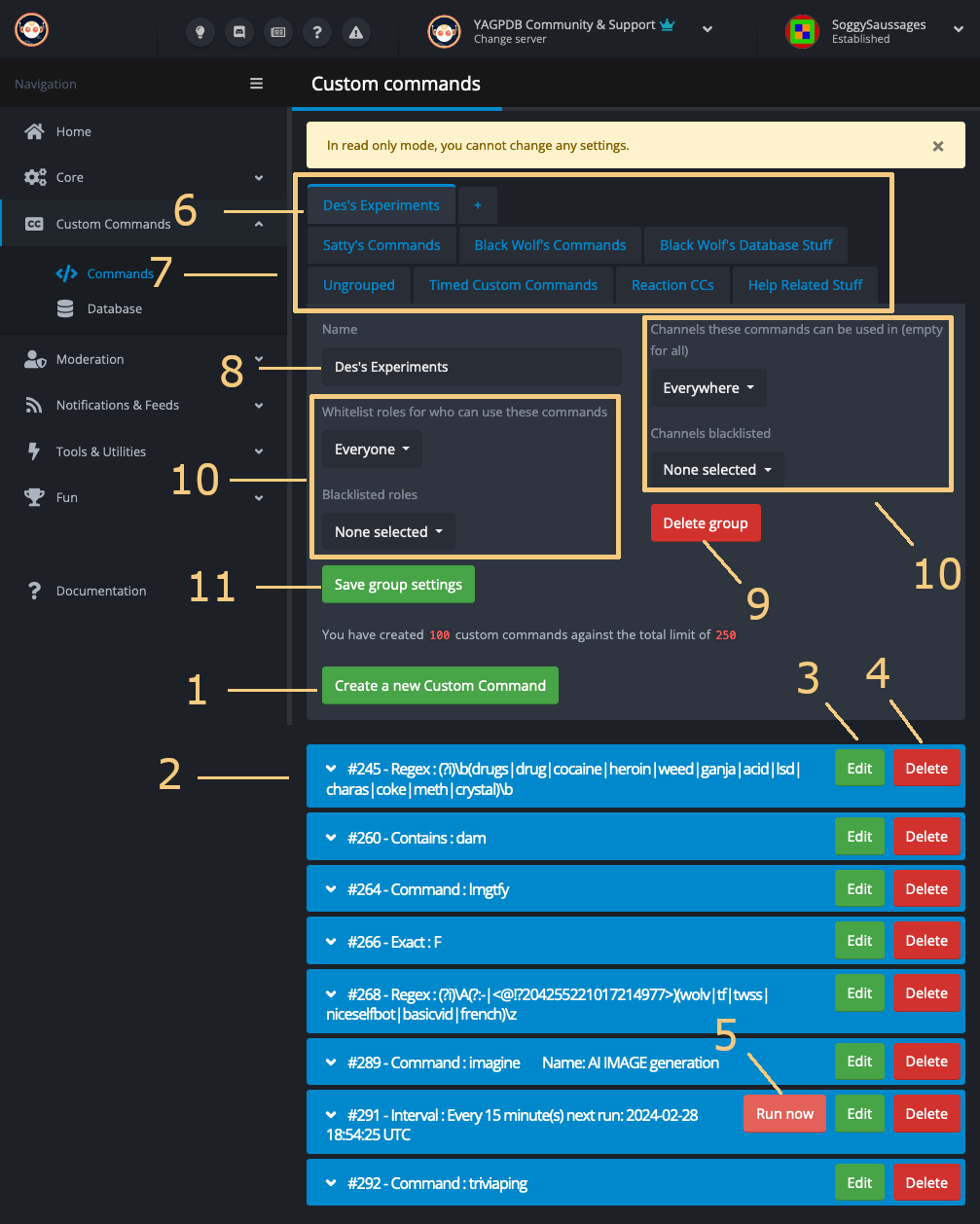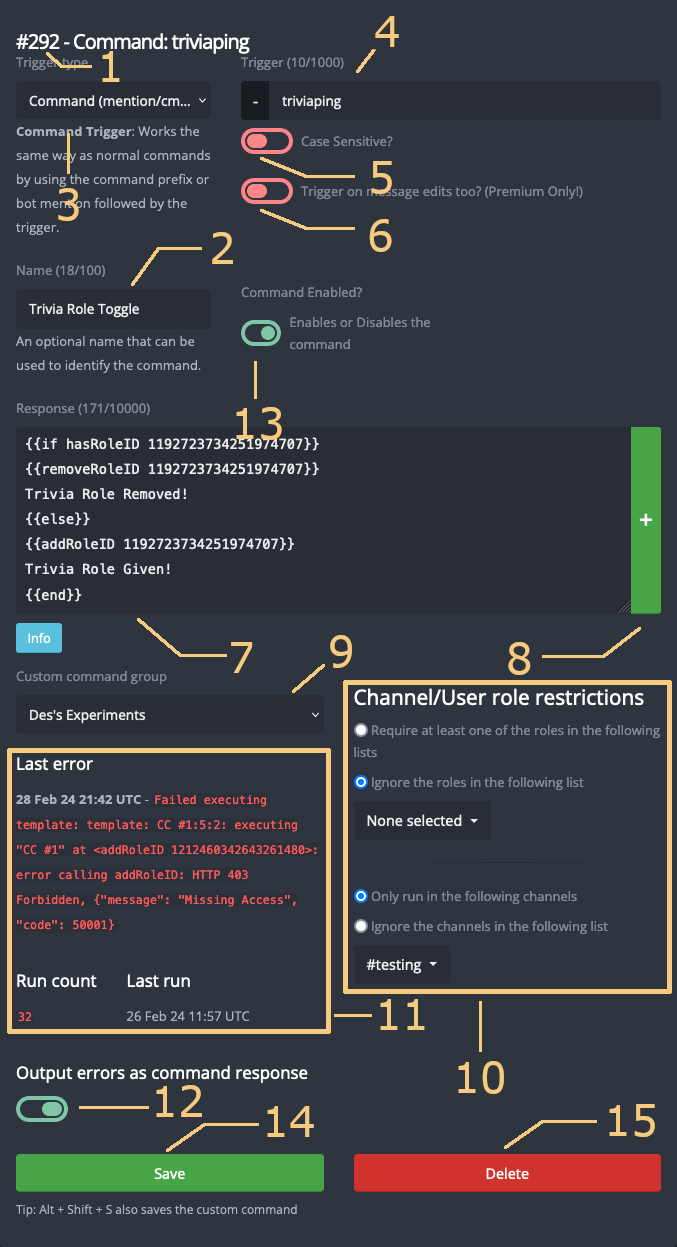Commands
On this page
The commands page displays all custom commands and allows you to add, delete, or edit custom commands and custom command groups.

1 Create Custom Command 2 List of Commands in Selected Group 3 Edit this Custom Command 4 Delete this Custom Command 5 Run this Command Now 6 Selected Group 7 Group Tabs 8 Name of Selected Group 9 Delete Selected Group 10 Channel and Role Restrictions 11 Save group settings
Creating a Custom Command
Clicking the Create Custom Command (1) creates a new command within the selected group (6) and redirects you to a page to edit it.
A new custom command has the default response:
Edit this to change the output of the custom command {{.CCID}}!Each custom command is assigned a unique incrementing ID, which cannot be modified after creation.
Troubleshooting

If the bot is sending messages such as this in your server, you are likely accidentally triggering CCs with the default response. Check the commands page to find any CCs with empty responses.

Command List
The commands page lists the commands (2) in the selected group (6). They are ordered by ID and display their name (if set), trigger type, and trigger text (if applicable). You can expand the command by clicking on it, which displays the full command response.
Delete a Command
Deleting a custom command (4) will permanently delete the command after confirmation. This cannot be undone.
Run Now
The Run now button (5) appears on interval trigger commands. When clicked, it executes the command immediately as long as the command isn’t disabled and a channel is selected.
Running an interval command using this button reschedules all subsequent runs based off the current time.
Command Groups
Command groups allow you to organize your custom commands and apply role and channel restrictions to multiple commands.
The group tabs at the top of the page (7) allow you to switch to any of your created groups. The + button allows you to create a new group.
Editing a Group
Selecting a group allows you to edit it. Changes must be saved (11) to take effect.
- Name (8): Name your custom command group (100 characters max).
- Delete group (9): Permanently delete the group after confirmation.
- Role/Channel restrictions (10): Restrict commands within the group based on roles or channels executed in.
- Save group settings (11): Update the group with the new values.
Role/Channel Restrictions
Using role/channel restrictions, it is possible to set conditions on which users can trigger a custom command.
Specifically, whitelisted roles or channels are required to run the command, whereas blacklisted roles or channels cannot use the command at all.
Note
YAGPDB was raised well and honors a “no” when told “no”. In other words, blacklists take precedence over whitelists.
This is a relatively common trip-hazard, so take great care when you set up both whitelists and blacklists.
Note
Role restrictions are unrelated to member permissions. Having Administrator permissions will not override these
restrictions.
Editing a Custom Command
Editing a custom command (3) opens a separate page for configuration.

1 ID 2 Name 3 Trigger Type 4 Trigger Text 5 Case Sensitivity Toggle 6 Message Edits Trigger Toggle 7 Response 8 Add Response 9 Custom Command Group 10 Channel and Role Restrictions 11 Execution Statistics 12 Error Output Toggle 13 Enable Command Toggle 14 Save Command 15 Delete command button
ID and Name
Custom commands are identified by either their ID or their name.
When a custom command is created, it is assigned a numeric ID (1) starting at 1. The number increases with
each custom command created on your server. It is not based on the current number of custom commands, but the total
commands that have ever been created on the server. IDs cannot be changed by the user.
The ID uniquely identifies a custom command, and is therefore used in a variety of contexts where one needs to supply a
specific custom command. For instance, the execCC custom command function targets a specific CC ID, and some built-in
commands like customcommands accept a CC ID as an argument.
Within a command response, the ID may be retrieved using the {{ .CCID }} template.
Danger
Deleting a custom command does not allow its ID to be reassigned. If you delete a CC, its ID is lost forever.
A Custom Command’s name (2), conversely, is defined by the user. It is an optional argument that can be used to
identify the command in the control panel and with the CustomCommands command. Max 100 characters.
Triggers
A trigger (3) defines conditions under which the command will be executed. Depending on the type of trigger, you may also need to specify additional configuration. For example, most trigger types require a Trigger (4) field defining the text the command should match against new messages. Max 1000 characters.
Trigger types
Command
Messages starting with the prefix for your server (- by default) OR by mentioning the bot followed by the trigger text (4) will trigger the command.
Example
Trigger: say
Matches:
-say
-say hello
@YAGPDB.xyz say hello
Doesn’t match:
say hello
-sayl hello
Starts With
Messages starting with the trigger text (4) will trigger the command.
Contains
Messages containing the trigger text (4) will trigger the command.
Regex
Messages matching the trigger text (4) as a regex pattern will trigger the command.
Exact Match
Messages which exactly match the trigger text (4) will trigger the command.
Reaction
Reactions to a message will trigger the command.
Can specify Added Only, Removed Only, or Both to restrict which types of Reactions will trigger the command.
Filtering Emojis
You cannot specify which emojis the command will trigger on. If you’d like to limit which emojis run the code, you will need to write that code yourself in the response.
Example:
{{ if eq .Reaction.Emoji.APIName "😀" "⭐️" }}
This is an allowed reaction!
{{ else if eq .Reaction.Emoji.APIName "🦆" }}
This is not an allowed reaction.
{{ end }}
{{/* Emojis other than 😀, ⭐️, and 🦆 do not produce any response. */}}Hourly/Minute Interval
These triggers will run the command at a regular interval of time – for instance, every 2 hours – in the selected channel.
When using an interval trigger, the custom command does not receive any user or member context. Thus, {{ .User.ID }}
and similar templates will result in no value and member-dependent functions such as addRoleID will fail.

1 Interval 2 Channel 3 Excluding hours/weekdays
Interval (1) sets how often the command will run in hours or minutes.
Channel (2) specifies a channel to run the command in. The response, if any, will be sent to this channel.
Excluding hours and/or weekdays (3) prevents the command from triggering during those hours or weekdays. This uses UTC time, not your local timezone.
When editing an interval command, a Run Now button appears at the bottom of the page. It executes the command as long as the command is not disabled and a channel is selected. Running an interval command using this button reschedules all subsequent runs based off the current time.
Note
You must specify a channel to run interval commands in even if the command doesn’t output a message.
Component
The component trigger is used to trigger custom commands via buttons or select menus.
The trigger is matched using RegEx.
Modal
The modal trigger is used to trigger custom commands via submitting a modal.
The trigger is matched using RegEx.
Case Sensitivity
Any commands which allow you to specify trigger text (command, regex, exact match, and so on) have a Case
sensitivity toggle (5) which is off by default. A case-sensitive trigger yagPDB will trigger on “yagPDB” but not
“yagpdb” or “YAGPDB”.
Edit Message Trigger
This feature is premium only.
Commands which trigger on messages have a Trigger on message edits toggle (6) which is off by default. If a message is edited and matches the trigger text, it will trigger the command.
The edited message toggle is an additional trigger to the normal message trigger. If you’d like to only trigger on
message edits, you will need to use a conditional branch on {{ .IsMessageEdit }} in the custom command response.
Response
The response (7) defines the message the bot will send once the command is triggered.
Optionally define multiple responses which the bot will randomly select from when the command is run. Add a response with the plus button on the right of the response (8).
The response supports the custom template script, allowing for more complex functionality such as assigning roles, getting data from users, sending messages to other channels, and more. Visit the Templates reference page to learn more.
Keeping your code safe
It is recommended to save local copies of your custom commands. There is no way to recover deleted or overwritten CCs. Use an editor like Vim, VS Code, or Notepad++ for the best coding experience.
Custom Command Group
Dropdown selection (9) to change which command group the command is in. Select None to ungroup the command.
Channel and Role Restrictions
Group restrictions operate identically to command-specific restrictions.
CC Groups
A user executing a command must obey both the overarching group’s restrictions and the command restrictions. Command-specific whitelists will not override the group restrictions.
Execution Statistics
The execution statistics (11) show details about the custom command’s executions. It is updated after each command run.
Last Error
The most recent error which occurred running the command, UTC timestamped. The error display is not cleared when the command runs successfully.
Run Count
A count of how many times the command executed the response. This counter increases even if the command errors, or does
not send a response. It also increases if the command is run via execCC.
The run count will not increase if the user who ran the command did not pass the restrictions.
Troubleshooting
If your command fails to run, check the run count. If the run count increases when you attempt to run the command, the issue is with your code. Otherwise, the issue may be with YAGPDB’s permissions in your server, or improperly configured role/channel restrictions in the command and/or command group.
Last Run
A UTC timestamp of the last time the command executed the response.
Next Scheduled Run
Only shown on Interval type commands. A UTC timestamp of the next time the command is scheduled to run.
Output errors as command response
This toggle (12) determines whether errors during command execution are sent in the command response after the command fails. Does not affect logging of Last Error to the statistics.
Command Enabled
This toggle (13) enables the command. A disabled command will never run (not even with execCC) or count against
the trigger limit.
Saving Your Command
Saving (14) the command updates it with the new values if there are no errors.
Alt + Shift + S also saves the custom command.
A custom command will not save if there is an error in your input. Examples of errors which prevent you from saving:
- There is a syntax error in the response
- You have reached the maximum CC limit
- You are attempting to save an empty response
If you save a command with an interval trigger which has never been run, it will run immediately upon saving.
Keeping your code safe
It is recommended to code your custom command using a local editor on your device. You will not be able to save your code on the dashboard if there are syntax errors in your code. Use an editor like Vim, VS Code, or Notepad++ for the best coding experience.
Danger
Custom commands do not autosave.
Delete Current Command
Deleting the custom command (15) will permanently delete the command after confirmation. This cannot be undone.